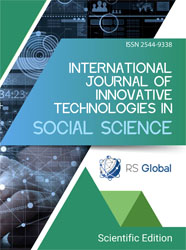INSTITUTIONAL STRATEGY VS. REAL-TIME RESPONSE: DISCOURSE PATTERNS IN COVID-19 PRESS CONFERENCES
Abstract
The COVID-19 pandemic triggered a global crisis that had far-reaching consequences beyond public health. It disrupted every aspect of human life and global systems. Responsible persons on crisis management had to play a vital role in making decisions, allocating resources, enforcing policies, along with effective communication, which comprised disseminating accurate information, countering misinformation, and encouraging adherence to safety protocols. Despite the prevalence of online communication and social media, global crises have demonstrated that news conferences are still the preferred technique of information dissemination. Press conferences are not chosen at random for political speeches, rather, they are valued for their procedural and general characteristics, particularly in situations of crisis, due to their interactive, dynamic, and collaborative nature. A press conference is a rhetorical response to an urgent situation, with three basic speech acts: introduction, defense of a position and addressing skepticism. These communication acts are carried out through a various strategic maneuver. The study highlights the significance of press conferences in crisis situations and their role as a strategic communication tool. While press conferences undoubtedly serve institutional needs, the debate remains as to whether they represent intentional strategic communication or emergent responses based on situational factors. Strategic communication can range from intentional to emergent, depending on the context. The research provides a corpus-based comparative and contrastive analysis of a limited number of COVID-19-related discourses from press conferences held by authorities in the USA. Thus, the study focuses on: i. determining the frequency and distribution of pre-selected markers based on a generic analysis of COVID-19-related discourse; ii. examining the pragmatic value of the markers and their intended impact on the audience; iii. comparing and contrasting the frequency and distribution of discourse markers in monologue and question-and-answer (Q&A) segments; iv. identifying the type of strategic communication present in COVID-19 press conferences. The study contributes to a greater understanding of the press conference as a strategic communication tool, rather than as a random channel for information distribution. It explores how press conference functions as strategic communication, ranging from intentional to emergent, shaped by institutional responsibilities.
References
Andone C., Argumentation in Political Interviews: Analyzing and Evaluating Responses to Accusations of Inconsistency, Amsterdam:John Benjamins. doi:10/1075/aic.5, 2013
Bitzer, L. F., The rhetorical situation. Philosophy and Rhetoric, 1(1), 1–14. https://www.jstor.org/stable/40236733, 1968
Clayman, S., and Heritage, J., The News Interview: Journalists and Public Figures on the Air. Cambridge:Cambridge University Press.doi:10.1017CBO9780511613623, 2002
Ekström, M., & Eriksson, G. Press conferences. In R. Wodak, & B. Forchtner, 2015
Fuller-Love A. and Cooper C., Strategic Management and the Dynamics of Organizational Change: A Systematic Review of the Literature, Journal of General Management, 2000
Galperin I.R.Stylistcs, Higher School Publishing house, Moscow,1977
Hallahan et al., Strategy use and problem-solving in a complex decision-making task, Journal of Experimental Child Psychology, 2007
Mintzberg. H., Crafting Strategy, Harward Business Review, 1987
Thornborrow, j., Power Talk:Language and Interaction in Institutional Discourse. London:Longman, 2002
Van Eemeren, F.H., Strategic Manuevring in Argumentative Discourse: Extending the Pragma-Dialectical theory of Argumentation. Amsterdam:John Benjamins. doi:10.1075/aic.2 ,2010
Vatz, R. E., The myth of the rhetorical situation. Philosophy and Rhetoric, 6(3), 154–161. https://www.jstor.org/stable/40236848, 1973
Wang H. and Ge Y., (corresponding author), The discursive (re)construction of social relations in a crisis situation: A genre analytical approach to press conferences on COVID-19 in China, Front Psychol, 2022 Nov 8. doi: 10.3389/fpsyg.2022.99181
https://www.youtube.com/watch?v=5jIb8HjA1Io
https://www.youtube.com/watch?v=icwXFrwOwiY
https://www.presidency.ucsb.edu/documents/the-presidents-news-conference-1262
Views:
81
Downloads:
40
Copyright (c) 2025 Tamta Goradze, Zeinab Gvarishvilii

This work is licensed under a Creative Commons Attribution 4.0 International License.
All articles are published in open-access and licensed under a Creative Commons Attribution 4.0 International License (CC BY 4.0). Hence, authors retain copyright to the content of the articles.
CC BY 4.0 License allows content to be copied, adapted, displayed, distributed, re-published or otherwise re-used for any purpose including for adaptation and commercial use provided the content is attributed.











